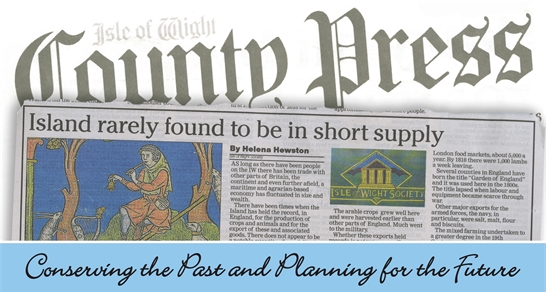January 2018
Island Rarely in Short Supply
Helena Hewston
As long as there have been people on the Isle of Wight there has been trade with other parts of Britain, the continent and even further afield. A maritime and agrarian based economy has fluctuated in size and wealth. There have been times when the Island has held the record, in England, for the production of crops and animals and for the export of these and associated goods. There does not appear to be a notable quantity of specialised goods imported but the manors and major houses did bring in fine ornament and fabrics.
The goods for the general public, food and commodities for the military, on and off the Island, generated these records in production and trade. Tools, pottery and food and wine were early imports but it was when the Romans came here that the Isle of Wight became a grain exporter. The arable crops of wheat, barley, oats, vetches and beans grew well here and were harvested earlier than other parts of England. Much went to the military. Whether these exports held records is not yet proven . It was not until Edward I that the size of the tonnage indicated superiority. For his military need in 1304, 850quarters (approx 10,795 kilos) of wheat were shipped out.
Wool was another commodity rising in recognition and price at that time. Garments were needed by everyone and a cloth called kersey was woven for export. The wool trade lasted three centuries. In the 1780s and 90s 40,000 sheep were shorn annually. The early lambs went to the London food markets, about 5,000 a year. The Island was considered the most important fat lamb supplier in England. By 1818 there were 1.000 lambs a week leaving in the spring and summer.
Hides from cattle were used for all leather goods. The tanning trade declined in the 1600s. There is a record of a stock of over 200 hides being sent to the mainland from Cowes.
Several counties in England have born the title “Garden of England” and it was used here in the 1800s. The title lapsed when labour and equipment became scarce through war.
Other major exports for the armed forces, the navy, in particular, was in salt, malt, flour and biscuits.
The mixed farming undertaken to a greater degree in the 19th Century produced milk surpluses which were churned into butter. This was one of the largest output of dairy goods per acre in the country.something in it that is associated with the Island.
One recent claim to intense acreage is with horses. There have been more per acre than elsewhere in Britain.Nowadays with just small changes, in marketing and transport, a record is easily broken but there is a products that has held a top spot in many kitchens and this is garlic.Not necessarily a record, but an interesting claim, is that every aeroplane has something in it that is associated with the Island.
Change can be slow. There are peaks and troughs. Who can say what our next record will be for what we produce?
[Go Back]

